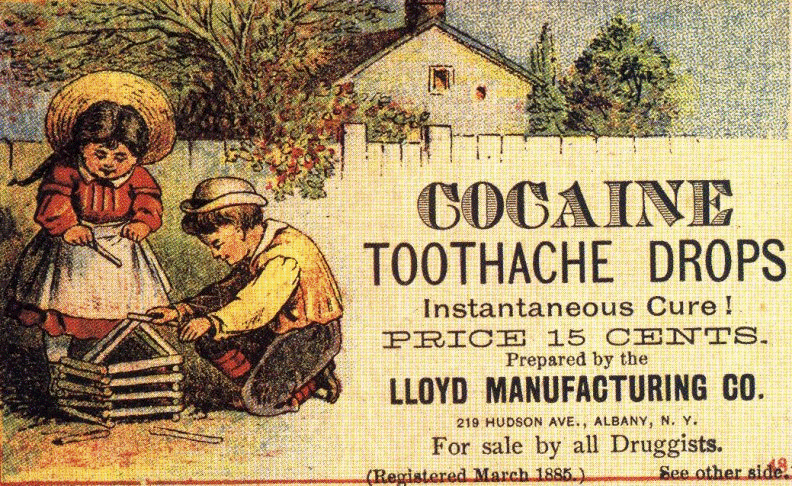For most of us, cocaine brings to mind the image of drug-fueled discos or wealthy Wall Street stockbrokers, feeding an insatiable habit. However, the history of this addictive stimulant is a far more interesting tale than one might imagine. Liz Greene explains.
The story of cocaine starts in the high mountain ranges of South America, where native Peruvians chewed the leaves of the coca plant in order to increase energy and strength. The stimulating effects of the leaf sped breathing, raising the oxygen level in their blood and countering the effects of living in the thin mountain air. Once the Spanish arrived in the 1500s, word of the coca plant and its interesting effects began to spread.
The Wonder Drug
In 1859, German chemist Albert Niemann isolated, extracted, and named the purified alkaloid cocaine from a batch of coca leaves transported from South America. Despite the detailed information he provided on the alkaloid in his dissertation, it wouldn’t be until later in the century that its effects were recognized in the medical community.
As medical experiments testing cocaine’s analgesic properties began, other doctors were studying the drug’s more stimulating traits. In 1883, Theodor Aschenbrandt, a German army physician, administered cocaine to soldiers in the Bavarian Army. He reported that the drug reduced fatigue and enhanced the soldiers’ endurance during drills. These positive findings were published in a German medical journal, where they came to the attention of famed psychoanalyst, Sigmund Freud.
Freud’s findings on cocaine were based widely on his own experience with the drug. Not only did he use it regularly, he also prescribed it to his girlfriend, best friend, and father. In July 1884, he published Über Coca, a paper promoting cocaine as a treatment of everything from depression to morphine addiction. He concluded,
Absolutely no craving for the further use of cocaine appears after the first, or even after repeated taking of the drug…
Unfortunately, he was not only wrong, he was already addicted.
A Wider Audience
Inspired by Paolo Mantegazza’s reports of coca use in Peru, French chemist, Angelo Mariani developed a new drink concocted of claret and cocaine. With 6 milligrams of cocaine in every ounce, Vin Mariani became extremely popular, even among such high hitters as Queen Victoria, Pope Leo XIII, and Pope Saint Pius X.
Motivated by the success of Vin Mariani, in 1885, a drugstore owner in Columbus, Georgia decided to formulate his own version. Unfortunately for John Pemberton, the county in which he lived passed prohibition legislation, forcing him to come up with a new recipe for his French Wine Nerve Tonic. In 1886 he created a new, nonalcoholic version based on both coca and kola nut extracts — giving rise to the name Coca Cola. The euphoric and energizing effects of the drink helped to skyrocket the popularity of Coca-Cola by the turn of the century. Until 1903, a standard serving contained around 60mg of cocaine.
But cocaine wasn’t limited to beverages. Throughout the early 1900s, unregulated patent medicines containing cocaine were sold en masse. Toothache drops, nausea pills, analgesic syrups — all were easy to obtain, and far more addictive than consumers realize. By 1902 there were an estimated 200,000 cocaine addicts in the United States.

A Serious Problem
As cocaine use in society increased, the dangers of the drug became more evident. In 1903, the New York Tribune ran an expose that linked cocaine to crime in America, pressuring the Coca-Cola Company to remove cocaine from the soft drink. Eleven years later, the Harrison Narcotic Act came into effect, regulating the manufacture and dispense of cocaine in the United States. With the passing of the Narcotic Drugs Import and Export Act in 1922, cocaine became so heavily regulated that usage began to decline sharply — and continued to do so through the 1960s.
In 1970, the Controlled Substances Act was signed into law by President Richard Nixon. It classified cocaine as a Schedule II Controlled Substance, meaning the drug could only be possessed with a written prescription of a practitioner. This allowed for cocaine to still be used medically as a topical anesthetic, but not recreationally.
The passing of the Controlled Substances Act didn’t stop the popular media of the time from portraying cocaine as fashionable and glamorous. Rock stars, actors, and other popular figures of the time brandished paraphernalia like a trendy accessory, and America’s urban youth were watching.
Around this same time, a new, crystallized form of cocaine — known as crack — appeared. This cheaper alternative to cocaine made a name for itself in low-income communities during the 1980s. With such a high rate of addiction, users were willing to do almost anything for their next hit — leading to a dramatic rise in crime and a moral panic labeling crack as an epidemic.
Though cocaine use has steadily declined in recent years, the drug is still gathering about 1,600 new users each day. More than 40,000 people die from drug overdoses each year in the U.S — around 5,000 of which are due to cocaine. It seems as though cocaine isn’t quite ready to let go of its place in society — nor does it appear to be going away anytime soon.
Did you find this article interesting? If so, tell the world – tweet about it, like it, or share it by clicking on one of the buttons below…
